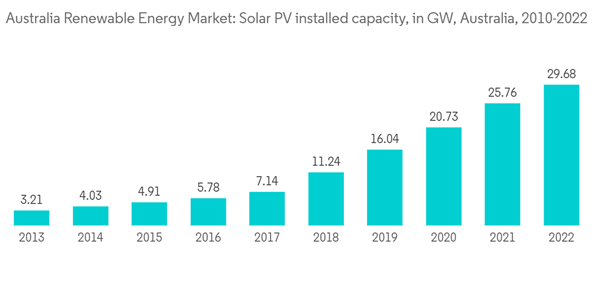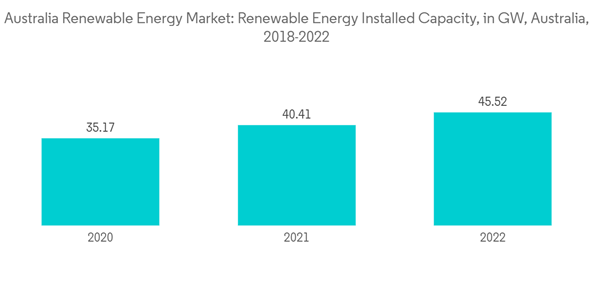Key Highlights
- Over the medium term, the prominent factors driving the growth are the issues related to elevated grid electricity prices and increasing investments in renewable energy generation in the country.
- On the other hand, the market's growth is expected to be hampered by factors like integrating renewables into the main electricity grid, which involves more challenges than installing them in the distributed form.
- Nevertheless, coal-fired power stations, which form a major part of the country's electricity generation, are aging and will retire after a certain period. They will not serve the country in the long run, which creates ample opportunity for the renewable energy market players to carve out a significant place in the power generation mix.
Australia Renewable Energy Market Trends
Solar Technology is Expected to Dominate the Market
- Solar power generation is expected to have a significant share during the forecast period due to the increase in distributed solar power installations or small-scale solar power generators in recent years.
- As per the Australian PV Institute, Australia's installed solar photovoltaic capacity was 29.7 GW as of December 2022, a 15.5% increase from the previous year. The electricity generated from Solar PV accounted for about 10 percent of the country's electricity in 2021. It emerged as Australia's fastest electricity generation technology, as per Australian Renewable Energy Agency.
- As part of Queensland's renewable energy targets, rooftop solar will be vital in helping it achieve its renewable energy goals. As of April 2023, over 780,000 homes and small businesses across Queensland with rooftop solar, generating approximately 4,500MW of clean energy. With one in three Queensland homes using solar power, the state has the highest rate of household solar rooftop installations in Australia.
- Due to its vast geographical extent and sparse population density, many industrial, agricultural, and mining operations and communities in the Australian interior must either depend on long-distance transmission grids or microgrids powered by diesel or gas generators. Solar PV systems and battery storage provide a perfect alternative for delivering reliable power supply to industrial consumers in remote locations.
- For instance, in February 2022, Australian mining giant Fortescue Metals Group unveiled plans to build a massive 5.4 GW solar PV, wind, and battery energy storage project, the UarooRenewable Energy Hub, in Western Australia's Pilbara region. The project is expected to have a 3.33 GW solar farm, a 2.04 GW wind farm, and a battery storage farm with a storage capacity of 9.1 GWh. The project will connect Fortescue's mining operations at Eliwanathrough a 220 kV transmission line.
- Owing to these developments, solar technology is expected to dominate the Australian renewable power generation market in the near future.
Government Initiatives are Expected to Drive the Market
- The Australian Government is focused on developing bilateral energy and emissions reduction agreements with state and territory governments. The deals will improve energy reliability and affordability and help energy markets adopt lower emissions technologies.
- According to the International Renewable Energy Agency, in 2022, the total renewable energy installed capacity accounted for 45.51 GW, with an annual growth of 12.6% compared to the previous year. With the increasing investment in new renewable energy projects and the government's focus on renewable power, the market is expected to grow in the forecast period.
- The government has launched various financial programs to promote renewable energy and increase its adaption on various levels.
- For instance, the Australian Government released its budget for October 2022-23, which commits record funding of almost AUD 25 billion to clean energy spending, providing greater direction and supporting the government's net zero commitment by 2050. Additionally, it includes funding for renewable energy and clean energy projects that provide investors with opportunities.
- Among the new budget, approximately AUD 300 million has been allocated by the Australian government to develop community batteries and solar banks. The AUD 224.3 million Community Batteries for Household Solar Program will deliver up to 400 community batteries for storing excess solar energy. As part of the Community Solar Banks program, AUD 102.2 million will be made available to assist Australian households in accessing cheap solar energy.
- Among other things, the Queensland Energy and Jobs Plan, which was released in September 2022, set new goals of 70% renewable energy by 2032 and 80% by 2035, which builds on this long-standing goal. The Plan outlines a range of actions to facilitate investment and deliver clean, reliable, and affordable energy to households and businesses.
- Owing to the above points and favorable government initiatives are expected to drive the Australian renewable energy market for the country during the forecast period.
Australia Renewable Energy Industry Overview
The Australian renewable energy market is fragmented. Some of the major companies in the market (in no particular order) include Iberdrola SA, Xinjiang Goldwind Science & Technology Co., Ltd.,, Vestas Wind Systems AS, Tilt Renewables Ltd, and Acciona SA., among others.In February 2023, Tilt Renewables, a Melbourne-based project developer announced buying of a 50% stake in the up to 1.2-GW Forest Wind project in Queensland, Australia.
Additional Benefits:
- The market estimate (ME) sheet in Excel format
- 3 months of analyst support
This product will be delivered within 2 business days.
Table of Contents
Companies Mentioned (Partial List)
A selection of companies mentioned in this report includes, but is not limited to:
- Iberdrola SA
- Xinjiang Goldwind Science & Technology Co., Ltd.,
- Vestas Wind Systems AS
- Tilt Renewables Ltd
- Acciona SA
- First Solar Inc.
- Ratch Group PLC
- Edify Energy Pty Ltd
- Neoen SA
- APA Group










